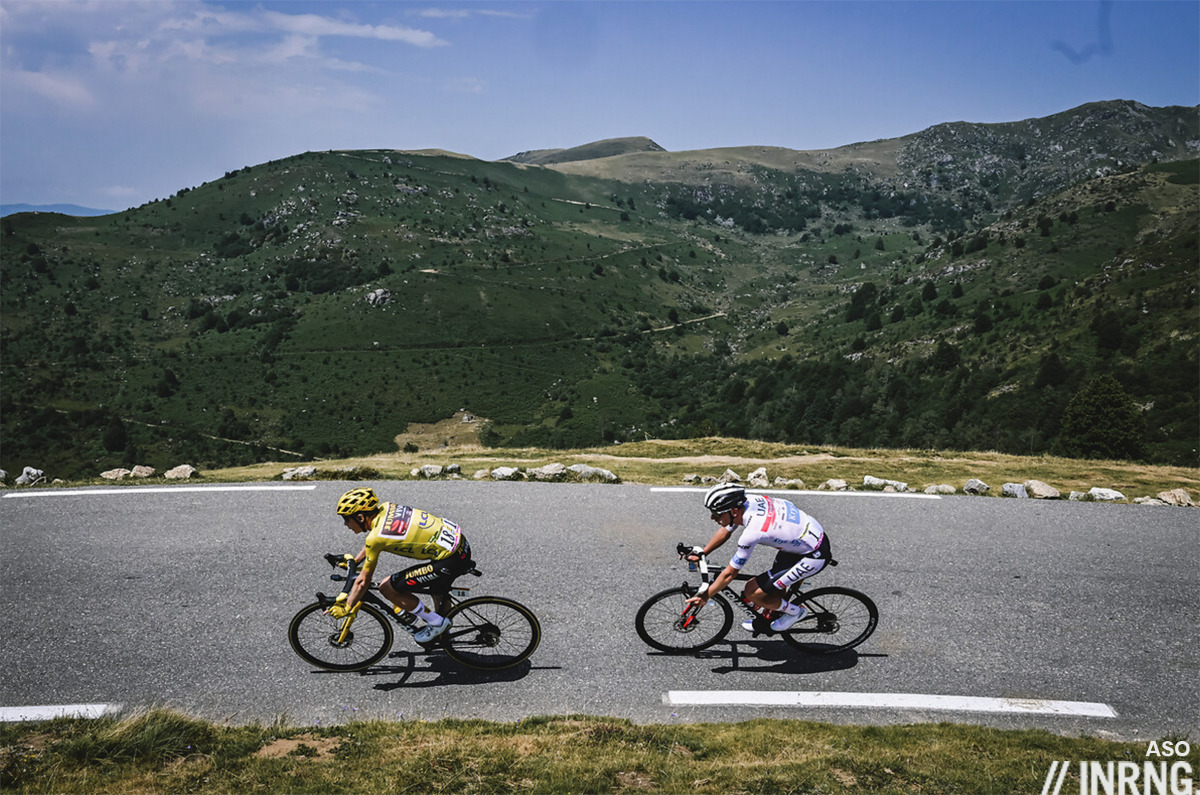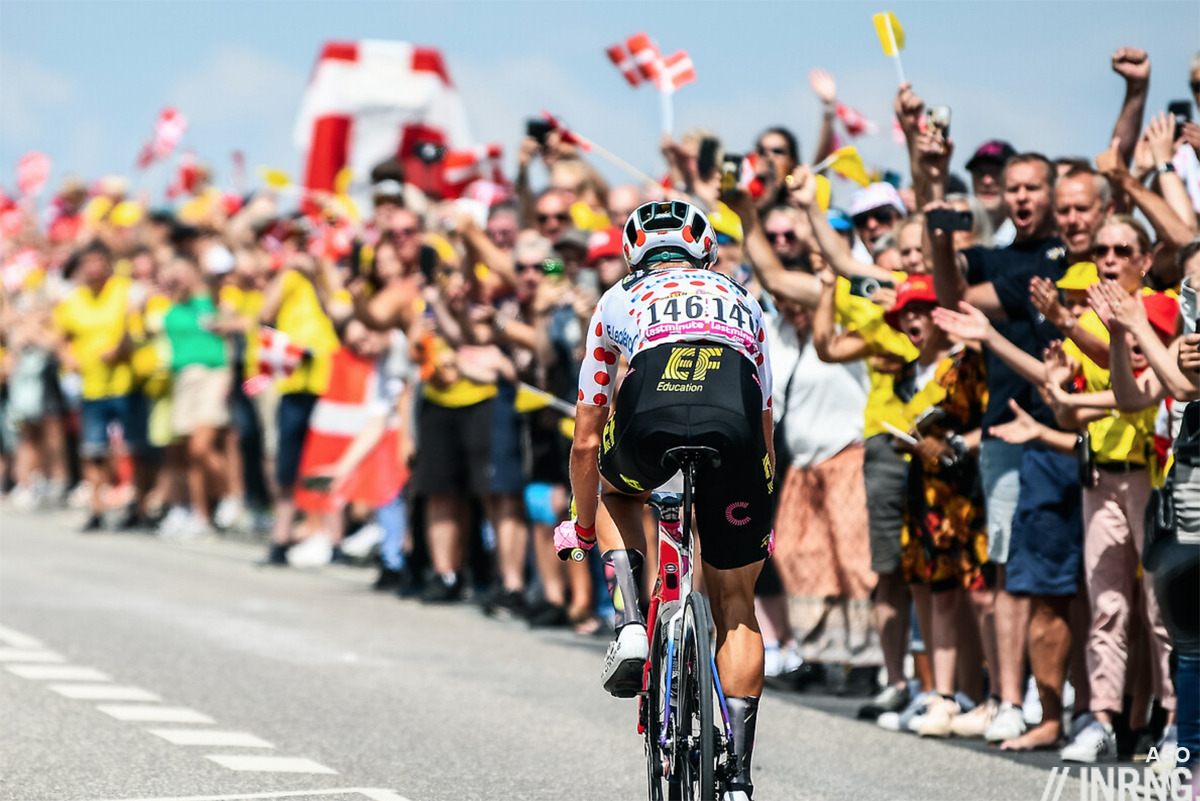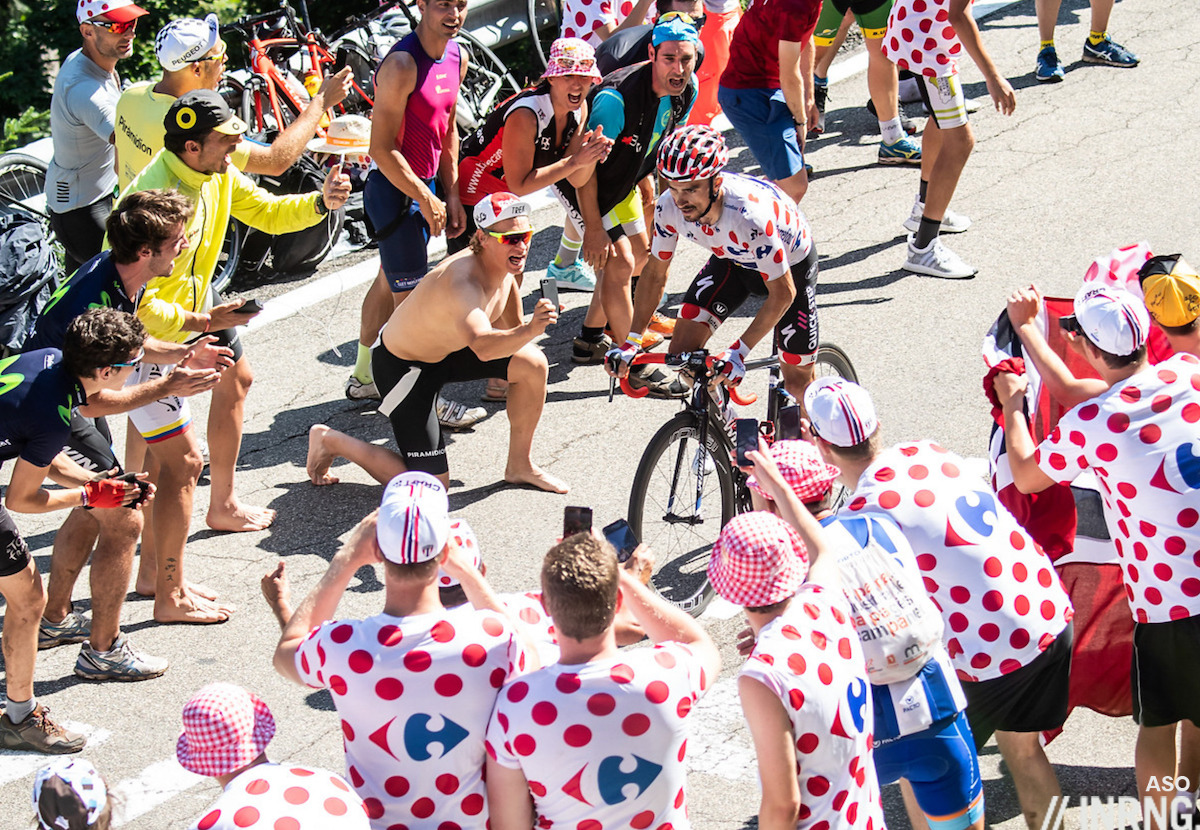A look at the contenders for the mountains competition in the Tour de France. The competition’s been exciting in recent years… until it suddenly wasn’t come the third week because the eventual winner in Paris suddenly took lots of points late on and the contest was over, the heroic raider who’d built up a lead thanks to breakaways on mountain stages suddenly got overhauled. This year’s course gives the raiders and pure climbers more of a chance… just.
Having set out two routes to the green jersey, there are also two base scenarios for winning the polka dot jersey.
The first is the “accidental” route whereby the winner of the Tour de France wins the prize without targetting it, they’re so good in the mountains that they collect enough points to take the jersey thanks to their summit finish stage wins. We’ve seen this since 2020 with the eventual overall winner of the Tour taking the polka dot jersey too, two wins for Pogačar and one for Vingegaard.
The other route is to go on mountain raids, taking points on the climbs mid-stage and hopefully hanging on for a stage win and with this, beaucoup points. Romain Bardet won the polka dot jersey in 2019 thanks to his raids but he didn’t win a stage, in fact he only passed one major climb in first place, a reminder that this is a points competition. Crucially our raider here has to lose time in the race in order to get space to go on the rampage and in this year’s route the Pyrenees come on Stages 5 and 6 with HC-rated climbs mid-stage each day so a raider who can collect points here already gets head start on the GC contenders who might hold on only to see their overall ambitions implode later.

Recent history makes Tadej Pogačar or Jonas Vingegaard obvious picks again, whoever you think is going to win the Tour is an obvious choice for polka dot too and while it’s very close to call between them for the overall, maybe Vingegaard shades it for the mountains as he’s proved superior in the long, high mountains but only just.
However this year there are some differences thanks to the route and the scoring system this year. Let’s look at the points first:
- Hors Catégorie double (Col de la Loze): 40-30-24-20-16-12-8-4 points
- Hors Catégorie (5 in total): 20-15-12-10-8-6-4-2 points
- Category 1 climbs (13): 10-8-6-4-2-1 points
- Category 2 (10): 5-3-2-1 points
- Category 3 (23): 2-1 points
- Category 4 (17): 1 point
In 2020 and 2021 they had double points for selected HC climbs with 40 points to the winner, typically the last climb of the day and so when Pogačar won Stages 17 and 18 in 2021 he collected 80 points here too and shot up the tables. For 2023 there’s only one double-rated climb, the Col de Loze on Stage 17 and presumably to make it sound even more important and to ensure some correlation between the mountains competition and perceptions of the “best climber”.

Still this single double award gives a big advantage to the GC contenders, look at the profile above and a raider could hope to take the first three climbs and win 10+10+5= 25 points before being mown down by the big GC teams and a big GC contender will score 40 points atop the Loze.

But a breakaway rider can hope to score on other days. Stage 14 above generously has three first category climbs mid-stage, the Cou and Feu passes aren’t easy but they could be second category. There are other stages with regular HC-rated climbs mid-stage too, think the Tourmalet on Stage 6. The short version of all of this is that a raider can score big but they’ll have to repeat this on multiple days.

Giulio Ciccone (Lidl-Trek) isn’t supposed to be here, the plan was to ride the Giro and then get married but Covid got him April and so he sat out his home race. He still got married mind you. He has said out loud he wants a stage win and the mountains jersey and completing the first can help go a long way towards winning the latter and with this as an explicit goal he can lose time early in the race to ensure he’s given some space, something several of the names below will only do if something’s gone wrong. He was excellent in the Dauphiné, on the attack and climbing with the best and in March he got the better of Primož Roglič and Remco Evenepoel in a summit finish of the Volta a Catalunya when few beat these riders but it shows he packs a sprint for stages and points alike. Easier said than done, he can expend a lot of energy to get in a breakaway on a mountain stage only for it to be doomed and a rival gets clear; plus the better team mate Mattias Skjelmose does, the more he could he held back on team duties.
 Thibaut Pinot (Groupama-FDJ) is here in support of David Gaudu but also says he’s up for “playing my card when the opportunity arises” and literally so given opportunity for Pinot comes every time the road rises and he’ll be roared on by expectant fans. But with the Giro in his legs, how many times can he sprint for the mountains? Pinot will have to shed time as well and if he doesn’t in the Pyrenees he won’t get much room. Also if David Gaudu doesn’t perk up then he too could be looking for other goals.
Thibaut Pinot (Groupama-FDJ) is here in support of David Gaudu but also says he’s up for “playing my card when the opportunity arises” and literally so given opportunity for Pinot comes every time the road rises and he’ll be roared on by expectant fans. But with the Giro in his legs, how many times can he sprint for the mountains? Pinot will have to shed time as well and if he doesn’t in the Pyrenees he won’t get much room. Also if David Gaudu doesn’t perk up then he too could be looking for other goals.
Felix Gall is making a name for himself this season and was climbing so well in the Tour de Suisse but how much can Ag2r Citroën afford to let him try the breakaways when they really want a big result for Ben O’Connor? Here’s where Aurélien Paret-Peintre could come in if he can stay with O’Connor. Right now just a stage win for Gall would please the team, a day ticket rather than a campaign but he was climbing so well in the Tour de Suisse that he could feature, a form pick.
Egan Bernal (Ineos) said he didn’t want to ride the Tour if it was just so suffer but few see him here for a full tilt at GC. He’s shown moments of being back towards his best so rather than grinding out a top-10 – less meaningful given he’s a past Tour winner – why not pick days for breakaways and the mountains. At his best he’s a crafty racer but not so punchy when it comes to sprinting for points, he’d have to push hard on climb well before the polka-dot arch to blunt the legs of rivals. Likewise for Dani Martinez and Tom Pidcock, if their GC ambitions for a high place are derailed then this is a decent alternative, especially as Ineos need some kind of demonstrable success this July.
Mikel Landa (Bahrain) is here for GC but if that goes wrong then here’s a back-up plan he can reach. He’s had a quiet season so far but the Tour has always been the goal. Pello Bilbao could feature here, he’s adept at breakaways and excels in the mountains and mid-mountain stages alike.
Simon Yates (Jayco-Al Ula) is another GC contender who could pivot to stage wins and the polka-dot should things go south.
Ditto Richard Carapaz (EF Education-Easypost) who is a podium contender until the day he isn’t, then he’ll switch to hunting stages and can aim for polka dot too, much like he did last year in the Vuelta when his GC bid wilted and he won three mountain stages. Neilson Powless could be an outside pick here too as a breakaway raider if his GC ambitions fade, he’s not expected to win but could aim for a top-10 with help from some breakaways.
Movistar have GC ambitions with Enric Mas and he’ll want support but if either Matteo Jorgenson or Ruben Guerreiro can seize their chances, why not. Jorgenson’s punchy and Guerreiro has won the 2020 Giro mountains competition.
Julian Alaphilippe? He’s won the competition in 2018 and there’s the problem, he’s 31 now and not as swashbuckling as he once was, he could pull out a big ride in July but can he keep it up every day? He’s not the best climber but you don’t have to be, he can deploy his uphill punch mid-stage.
Guillaume Martin? He’s tried stage-hunting before but says it’s cost him too much energy, he’d prefer to diesel around and secure a high overall finish and see what’s possible for a stage win.
Israel-PremierTech have Michael Woods and Dylan Teuns with Woods the better climber but accident-prone and Teuns punchy but less suited to the very high mountains but as the team is aiming to be a constant presence in the breakaways they can start scoring in the Pyrenees.
Arkéa-Samsic have moved up to the World Tour and its thanks to Astana’s poor run that they don’t look like the weakest outfit. Warren Barguil says he’s stage hunting only and his 2017 “legs of fire” are a long way back but Clément Champoussin was coming good in the Giro but he’s a wildman figure, up one day and down the next.
| Jonas Vingegaard | |
| Tadej Pogačar, Giulio Ciccone | |
| – | |
| Carapaz, Pinot, Alaphilippe, Bernal | |
| Martinez, Landa, S Yates, Woods, Gall, Teuns, Powless |

Polka-dot History
- The meilleur grimpeur “best climber” prize goes back to 1905 when the L’Auto newspaper, organisers of the race, started to label a rider but this was a subjective award
- 1933 saw the first formal points classification
- The competition got a dedicated jersey in 1975
- The polka dot design came about because Tour boss Félix Lévitan remembered the 1930s track cyclists Henri Lemoine and Marcel Guimbretière who raced together in a red and white polka dot jersey and these colours matched Poulain, the chocolate company that used red and white packaging at the time
- The red polka dot design has stuck despite the change of sponsors and it’s become so symbolic that many races use a dotted jersey for the mountains competition too
- The record is seven titles held by Richard Virenque


It’s round about now every year that my fantasy team gets tinkered with. What I was certain of yesterday is out of the window today. And tomorrow it’ll change again. I always end up kicking myself in any case.
Same… I’ve swapped out Ciccone for Alaphillipe and back 5 times today… and I’ll do it again 5 times tomorrow.
Really unsure between Ciccone and Pinot for the polka dots.
The non-GC candidates would be wise to lose time early on – why not stage 1? That way, you’re not chased, including by others in the top 10 or so.
If you’re someone like Pinot, this is worth much more than a top 10 on GC – that might be less the case for riders who have not ‘been there and done that’.
Am I right in assuming that your favourite for the GC is Vingegaard, given that you’ve awarded him 3 rings to Pog’s 2?
No. Re-read. He says that while they are very close for the overall Vingegaard shades the competition for polka dots
Is Vingegaard still eligible for the white jersey? If he is they might as well just have 2 jerseys. Green and best overall/mountain/not all that young rider for him and Pogacar to fight over.
Vingegaard is two years older than Pogacar, who is still eligible.
Maybe get rid of white jersey now, and have a sprinters’ jersey. Then, the green jersey can revert to being more about pure consistency rather than being weighted to sprinters.
Old guy’s jersey! Over 35. Gray of course. Think of the sponsor potential – every advertiser on the evening TV news programs – laxatives, pain-relievers, antacids…the sky’s the limit! 🙂
Silver not Gray!
Sure, it’s the same. 😉
I’d keep the white jersey but have it open only to u23 riders who are riding their first Tour. So its for, to use a horrible Americanism, best ‘rookie’.
Good idea
Although only Rodriguez and Skejlmose fit both criteria, so it wouldn’t be much of a competition!
If you widened it to riders who were under-23 at the start of the year, there would still only be 7 eligible riders.
Current rules – under 25 on 1 Jan – and a debutant would give you 18 competitors, or about 10% of the race, which seems reasonable.
Yes I like this version, plenty of riders take that bit longer to get to WT level eg Derek Gee would have been eligible if he had ridden, seems fair. Winning it multiple years in a row doesn’t seem right.
Only three riders won the white jersey thrice – Ullrich, Schleck, and Pogačar. There are others who won twice – Quintana and Pantani. All other previous winners took the white jersey just once. So… is there in fact a real problem with the young riders classification concept; rather than an exceptional contender, who is already at 25 a firm part of road cycling pantheon?
And while we consult the history chronicles… only Fignon, Ullrich, Contador, Schleck, Bernal and Pogačar actualy won both the general and young classification of the same race. Pogačar is the sole person to do it twice. As recently as 2018 the best young rider wasn’t even part of GC top 10.
yes, we’ll go with that then!
Although if you go back before the creation of the separate competition, there are several more winners who were under 25 at the start of the season:
Cornet
Trousselier
Petit-Breton
Faber
Lapize
Defraye
Thys (twice)
Maes
Bartali
Ancquetil
Gimondi
Aimar
Merckx (twice)
Hinault (twice)
I´ve always found the battle for the polka dot jersey curiously exciting during the first week when the course doesn´t take the riders to anything resembling a mountain.
We see riders who would be also-rans on proper mountain stage wear the polka dot jersey fight for one or two points and we see teams playing tactical games to either win a point or to steal a point from a potential competitor – and all for the relatively short glory and publicity the meilleur grimpeur gives them!
Alas, this year the Tour starts in the Basque country and the rider who´ll get to wear the jersey must have true mountain legs…
So is it now ‘meilleur grimpeur’ or rather ‘roi de la montagne’? Anyway the subtle tweaks in this competition might turn it into an actual exciting substitute for the GC contest which risks to become a bit boring.
I think ‘King of the Mountains’ was always an English term, rather than a translation from the French. You see ‘GPM’ written on French roads where it crests a climb, which I assume is ‘Grand Prix de la Montagne’, and there’s the ‘Etape Reine’ or Queen Stage (just because étape is a feminine noun), but I don’t think it was ever not ‘Meilleur Grimpeur’.
I think that I would rather be an alpiniste than a grimpeur.
Not that I disagree that there are now basically two routes to the polka dot jersey, but isn’t there a third one that is arguably more in line with the essence or purpose of the climbers’ competition? I’m thinking of the climbing specialist contender for the GC podium if not the win, who loses time in time trials etc., but wins this competition not simply “by accident” but because he out-climbs everyone else and for whom the polka dots become a target alongside, say, a top 5 or even a podium place in the GC (Quintana 2013 springs to mind).
It depends on the stock of GC contenders as well as the course design and in 2023, where climbing is THE main skill a GC contender needs to possess and where the main contenders are also the best climbers, chances are slim for this scenario to play out. But maybe Carapaz or Landa?
Warren Barguil was similar in 2017 too, if I remember correctly…I guess it’s a much less trodden path these days, where there’s so few time trials that the best climbers are the best GC contenders – it would be hard for somebody to out climb Pogacar and Vingegaard and not win the overall!
I believe Inrng contemplated the (recent?) shift, nowadays the best climbers are also time trial contenders (Froome, Pogacar, Vingegaard) and we won’t expect anyone to consistently outclimb them.
I’m impressed by how much effort our host has put into this analysis considering, due to the sheer number of possible contenders, it will only ever be a battle for the top two!